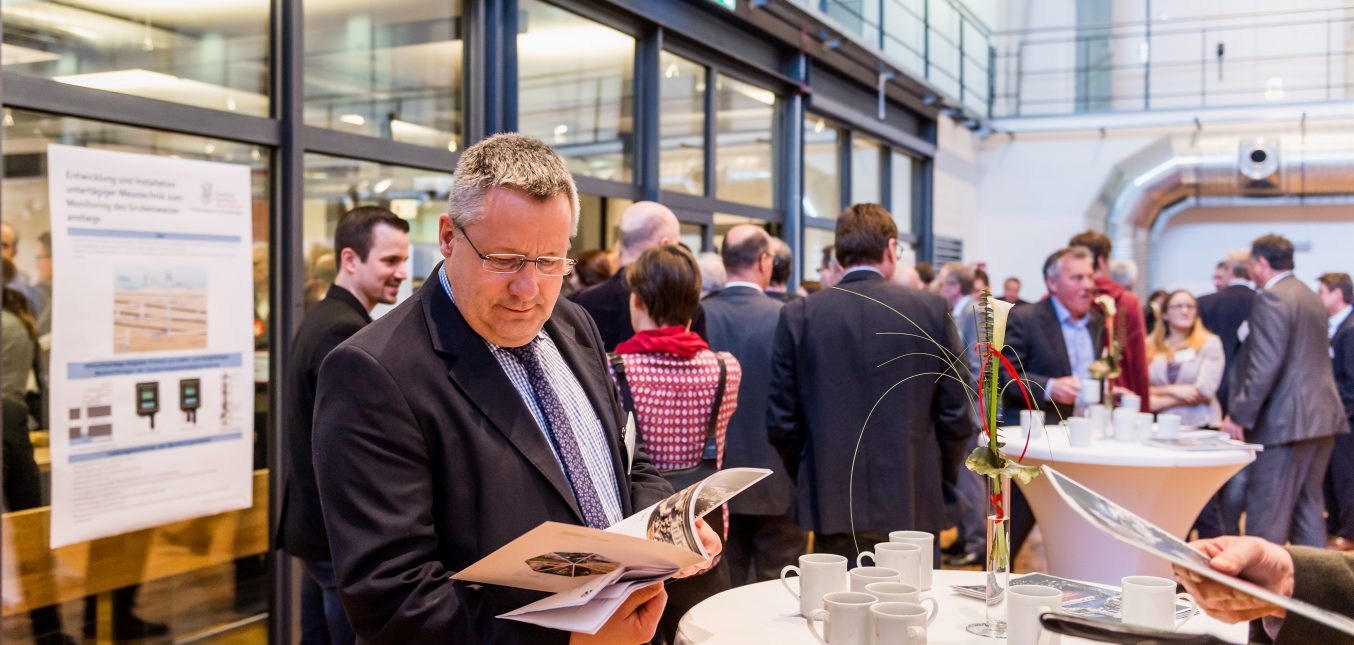Some 60,000 abandoned surface openings are left behind in the underground of North Rhine-Westphalia after mining over decades. Especially underneath the Ruhr area many cavities are slumbering, waiting to be scented and to be locked properly. However the post-mining time also offers extensive chances. Already for the fourth time the district council Arnsberg as mining authority and the TH Georg Agricola University of Applied Sciences organized the conference “NACHBergbauzeit in NRW” on March 23, 2017. 300 experts from Germany and Europe met in Bochum with this year’s focus on risk management. District president Diana Ewert and president of the TFH Georg Agricola Jürgen Kretschmann opened the event.
Even if coal mining will not end in Germany before 2018 already right now a lot is done. “Cavities underneath the central train station in Essen and cave-in events like the Höntroper hole or lately in Essen-Heisingen spotlighted the topic mining in the society” stated district president Diana Ewert during her welcoming speech. “Those show which risks can originate from inadequately secured and undocumented mining legacies. So far we could often only react, but today preventive actions are in the focus.”
Therefore companies, authorities and science already prepare themselves intensively how possible mining risks can be recognised early and coped with. “Post-mining requires an extensive risk management and modern control methods” stated president of the THGA Prof. Dr. Jürgen Kretschmann. “Future-oriented action of all involved parties, many of which are here today, is necessary to make post-mining time a good one. Cause it offers huge chances for the region for instance for urban development, job market or local recreation.”
The conference with the title “Recognizing and mastering risks – definitions, implementations, experiences” picked up post-mining challenges from various perspectives – from the perspective of the responsible mining authority, from company perspective or in the eye of scientific research. Also experiences from the Thuringian Kali-Südharz area or from the mine water rise at the mine Königstein close to Dresden, where Wismut GmbH mined uranium-bearing coal mine, were exchanged.
Which daily challenges are presented by the cave-in causing traces of mining for the mining authority NRW were clarified by Andreas Welz of the district council Arnsberg: the risk management old mining of the mining authority NRW covers at the moment 2,500 abandoned shafts, 940 of these in areas where no risk can be taken. In addition there are undiscovered cavities which are close to the surface. Together with the geological service NRW a database is developed with current information on the geographical spread of near-surface deposits.
Further presentations highlighted the terms “thread” and “risk” from a legal point of view or showed how different companies handle the topic post-mining: besides RAG Aktiengesellschaft also Thyssen Krupp AG or Netz AG of the Deutsche Bahn has to implement actions, which prevents preferably proactive damages. That this minimization of risks comes up against limiting factors, was pointed out by Tobias Friedrich, DMT GmbH & Co. KG, which has decades of experiences with minin exploration and restoration. “No one can guarantee a one-hundred-percent safety; there always remains an element of risk. Thus it is important to weigh up the relation between cost and benefit.” Because as complex as the risks of post-mining are the possibilities, how they are detected and what must be to detect them and what must be observed – from the research of old cracking to exploratory drilling with 3D laser scanner.
Also at the research institute of post-mining of THGA surveillance strategies are a main topic, for instance by planed mine water rise, by gas immigration or by exploitation of mining effects. Scientists use satellite remote sensing data to develop innovative monitoring procedures in old and post-mining. Thereby also an early-warning system for mining consequences is possible. “The structures of mining are for example causing alterations of the hydrologic balance, which we can register with satellites. This helps us to retrace spatiotemporal processes and to detect consequences on the day surface early.” Says Prof. Dr. Goerke-Mallet who presented current projects in his lecture. Of particular importance is therefore a responsible risk communication stressed Prof. Dr. Christian Melchers, Head of the Research Institute of Post-Mining. “To create a broad acceptance for subsequent actions post-mining developments have to be communicated with highest possible transparency The THGA and district council Arnsberg therefore want to inform politics, the public and expert groups at an early stage about problems, which need to be managed in the course of risk management, and to incorporate them in ongoing processes.
The conference NACHBergbauzeit in NRW is organized every two years in cooperation between district council Arnsberg and TH Georg Agricola University of Applied Sciences. In former years the aspects old mining (2011), subsequent use of former mining areas (2013) and mining water concept (2015) have been in the focus – the correspondent papers are now released as conference proceedings for the first time published by the university and the district council. The among experts well established conference shall be continued in the coming years.

